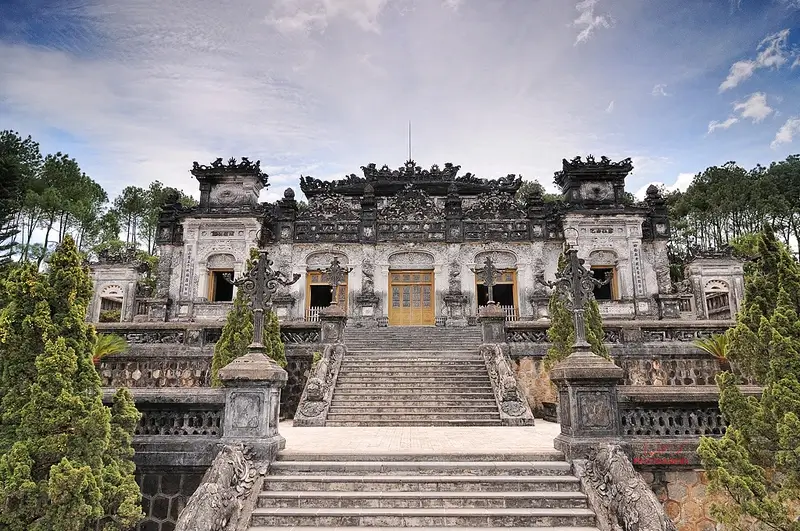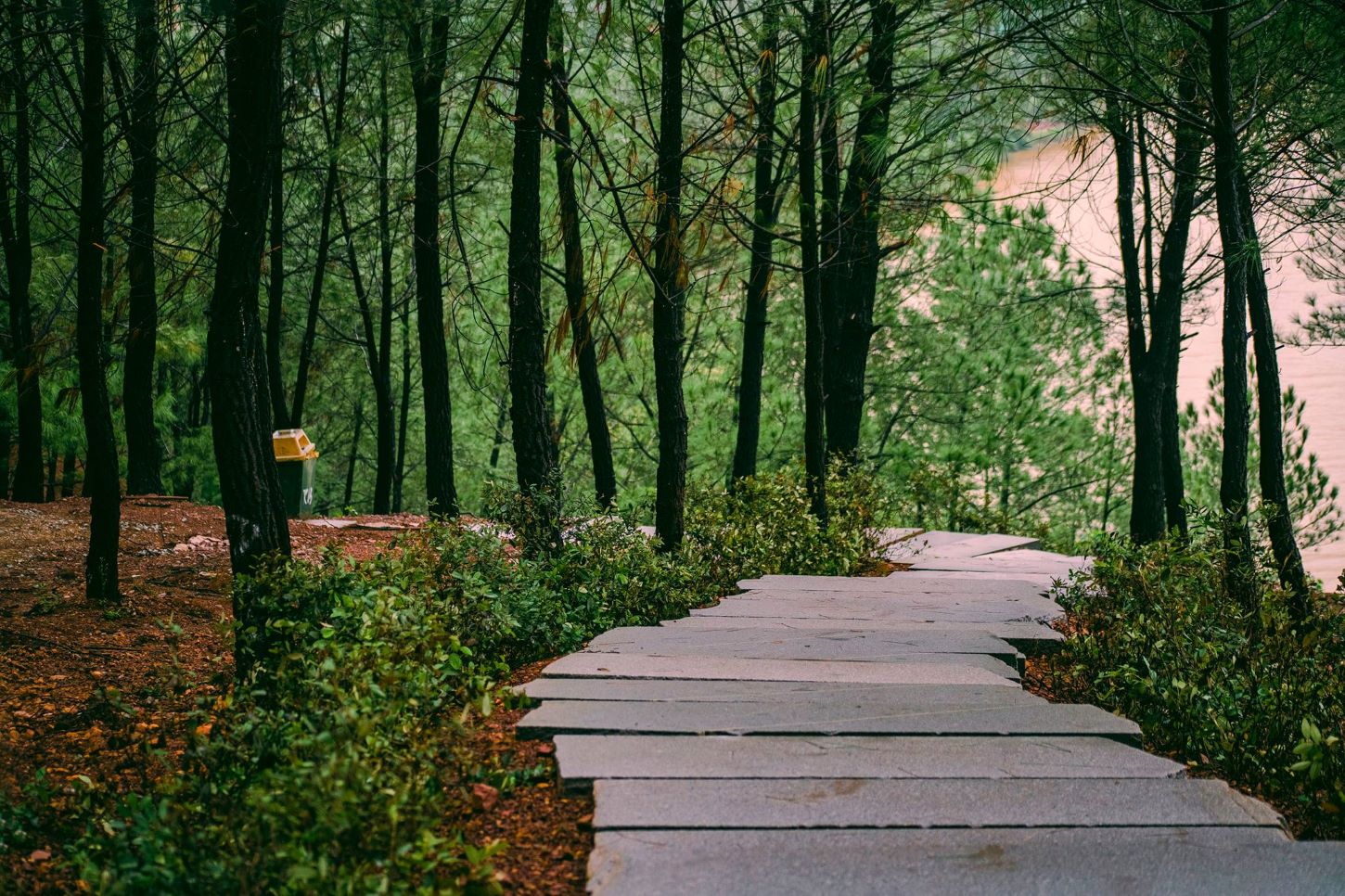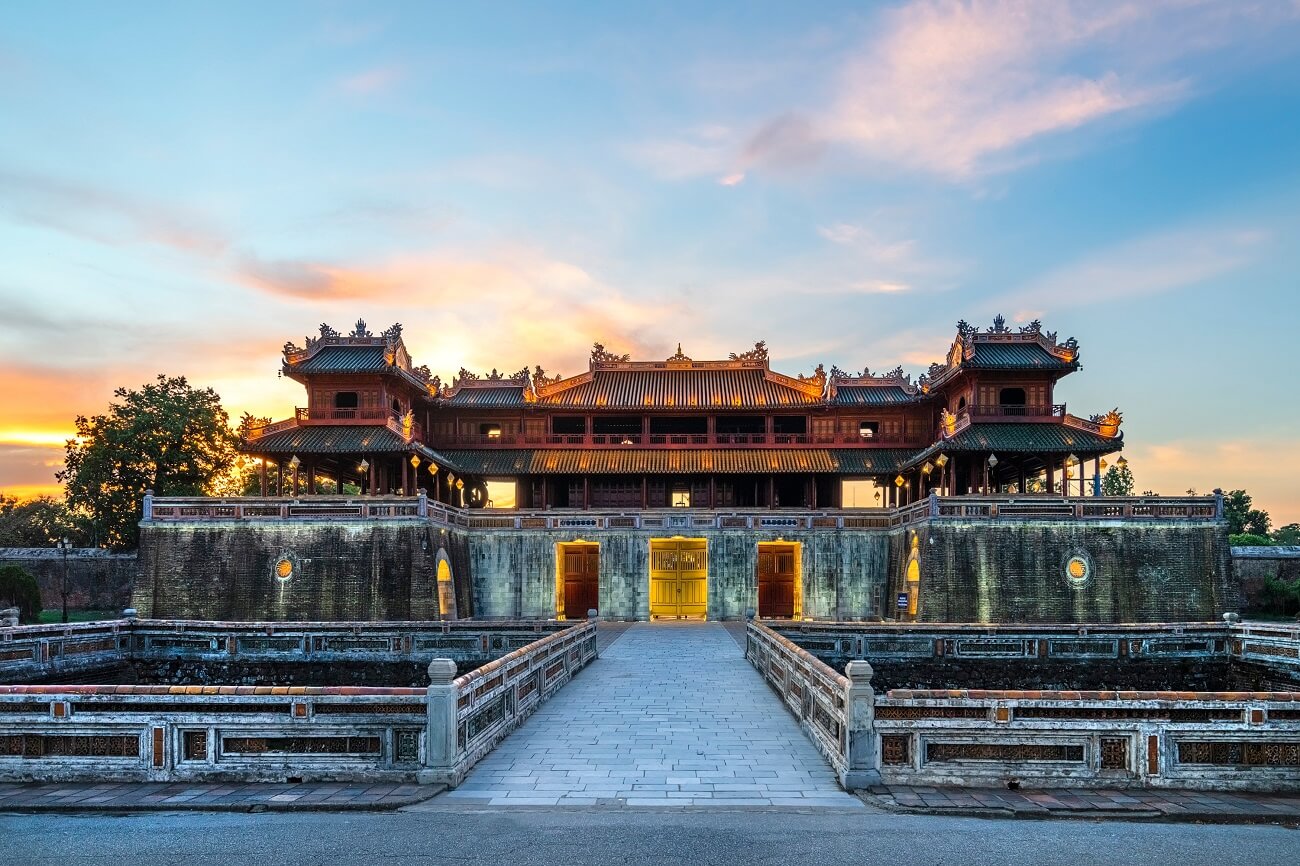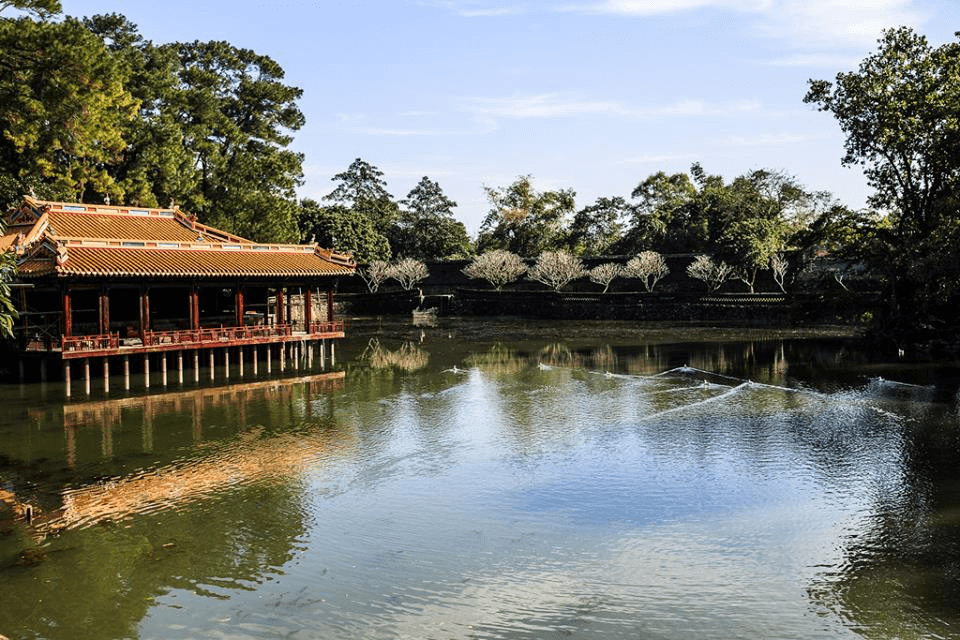When you arrive in Hue, it would be a shame to miss out on Khải Định Mausoleum – A prominent structure on the slopes of Chau Chu Mountain, where Asian and European architecture blend to create a majestic and unique beauty. With reasonable ticket prices for Khai Dinh Tomb, this is definitely a destination that should be included in any trip to explore Hue.
Together Queen Cafe Bus Discover the history, architecture, and fascinating stories of Khai Dinh Mausoleum in the article below, so that each photo you take will have its own unique touch!
1. Introduction to Khai Dinh Mausoleum
To make your visit to Khai Dinh Tomb complete and memorable, learn more about basic information such as its location, ticket prices, opening hours, and artistic highlights. These details will help make your journey of discovery in Hue more convenient and inspiring.
1.1 Where is Khai Dinh Mausoleum located?
Khai Dinh Tomb, also known as Ung Ling, is located on Chau Chu Mountain, in Thuy Bang Commune, Huong Thuy Town, about 10km southwest of Hue city center. This is the 12th tomb of the Nguyen dynasty, famous for the unique architecture of Khai Dinh Tomb, blending Asian and European styles to create a solemn yet distinctive beauty.
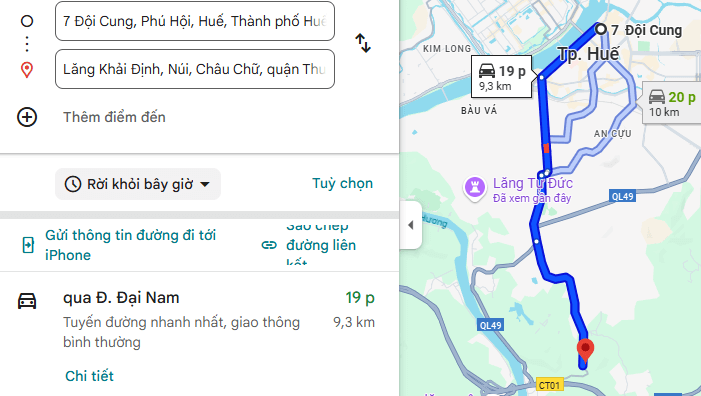
Detailed travel guide and map of Khai Dinh Tomb from 7 Team Cung
Starting from 7 Cung Teams, Phu Hoi Ward, Hue City, you can go to Khai Dinh Mausoleum, Hue via the fastest route through Dai Nam, covering a distance of approximately 9.3 km and taking an average travel time of 19 minutes when traffic conditions are favorable.
Suggested itinerary:
- From 7 Đội Cung, turn onto the main road and head south.
- Enter Dai Nam Road and continue straight ahead.
- Pass through the main intersections, keeping toward National Highway 49.
- Following the signs up Mount Chau Chu, you will see the entrance to King Khai Dinh's tomb on the mountainside, highlighted by stone steps leading up to the main hall.
Means of transportation:
- Motorcycle: flexible, easy to park for photos, rental price around 100,000–150,000 VND/day.
- Taxi/Grab: costs approximately 80,000–120,000 VND depending on the time of day.
- Private car/rental car: suitable for large groups or families.
1.2 Update on ticket prices for Khai Dinh Mausoleum in 2025 and opening hours
| Category | Adults | Children (ages 1–12) |
| Admission fee | 150,000 VND per ticket | 30,000 VND per ticket |
| Visiting hours & ticket sales | Summer (16/3 – 15/10) | Winter (October 16–March 15) |
| Open for tours | 6:30 AM – 6:00 PM | 7:00 – 17:30 |
| Ticket sales hours | 6:30 AM – 5:30 PM | 7:00 – 17:00 |
Note:
- The ticket price for Khai Dinh Mausoleum applies to both domestic and international visitors. Children under 7 years old are admitted free of charge.
- Opening hours and ticket sales hours may vary slightly during holidays or according to regulations from the heritage site management authority.
- To fully enjoy the experience and not miss out on admiring the paintings on the ceiling of Khai Dinh Tomb or the tomb's stunning architecture, you should leave early in the morning or arrive late in the afternoon to avoid crowds and the intense heat.
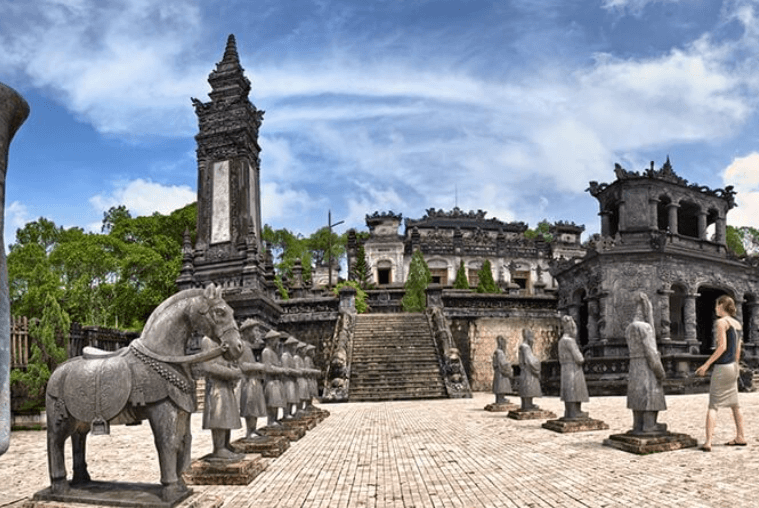
1.3 How long does it take to visit Khai Dinh Tomb?
Standing before the majestic Khai Dinh Tomb in Hue, you will find it difficult to simply pass by in a few minutes. To fully appreciate the architectural essence and historical stories here, take your time. at least 1.5–2 hours for the journey of discovery.
The ideal tour time will include:
- 15–20 minutes Explore the surrounding scenery and take photos of Khai Dinh Mausoleum from various beautiful angles.
- 45–60 minutes Admire the interior space, listen to or read the introduction to Khai Dinh Mausoleum to learn more about its architecture and history.
- 10–15 minutes Relax, enjoy the scenery, and buy a few small souvenirs.
With such unique architecture and meticulously carved details, Khải Định Mausoleum It's worth taking the time to explore rather than just stopping by briefly. As you leisurely walk up each step and admire the interior, you'll clearly feel the majesty, refinement, and artistic value that this building holds.
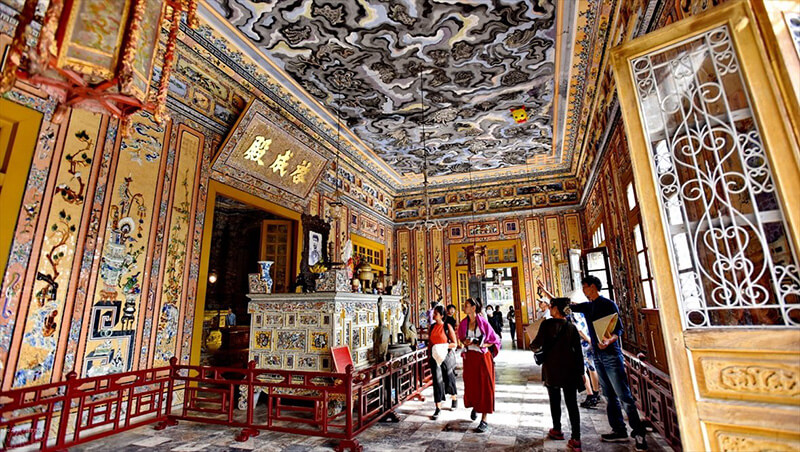
2. Journey to explore the architecture of Khai Dinh Tomb: Tour of 127 steps
2.1 Conquering 127 steps: From the Three-Gate Entrance to the majestic Bai Dinh Courtyard
Stepping into the Khai Dinh Tomb in Hue, you will begin your journey up 127 steps leading to the main hall – the place where the unique architectural essence of the Khai Dinh Tomb, one of the most distinctive of the Nguyen dynasty, converges. Each moss-covered stone step takes you back in time, from the majestic Tam Quan gate, through the courtyard with its orderly statues of soldiers, to the interior space resplendent with colorful porcelain and the mystical paintings on the ceiling of the Khai Dinh Tomb. Each step is a vivid snapshot of Hue's history and art.
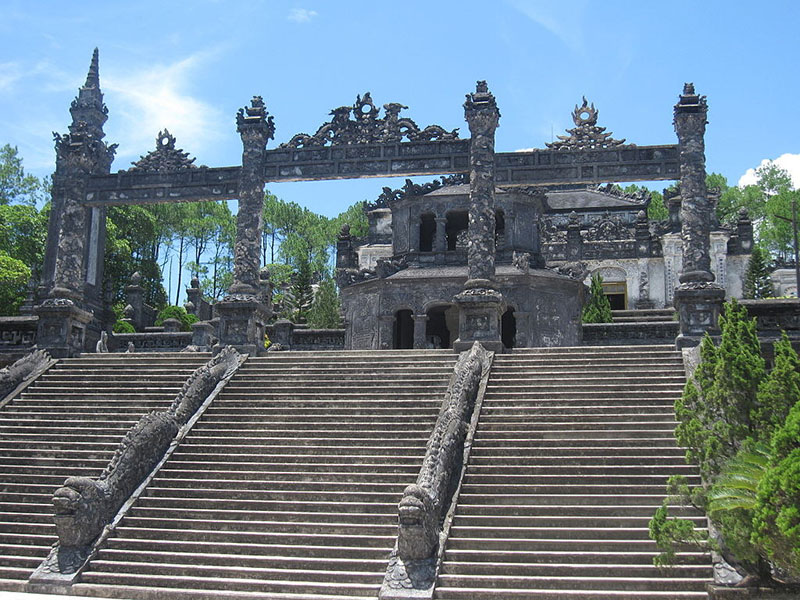
2.2 What's inside Khai Dinh Mausoleum? Discover the "heart" of Thien Dinh Palace
Inside the Khai Dinh Mausoleum is a world of exquisite art, and the Thien Dinh Palace is the "heart" of the entire complex. This is where the royal bed, the altar, and the statue of King Khai Dinh, cast in solid bronze and gilded with gold, are placed.
Surrounded by walls, ceilings, and columns decorated with tens of thousands of pieces of porcelain and colored glass arranged into vivid images of dragons, phoenixes, and flowers, every detail here conveys a message of power, aesthetics, and the cultural fusion of East and West, making it difficult for visitors to look away.
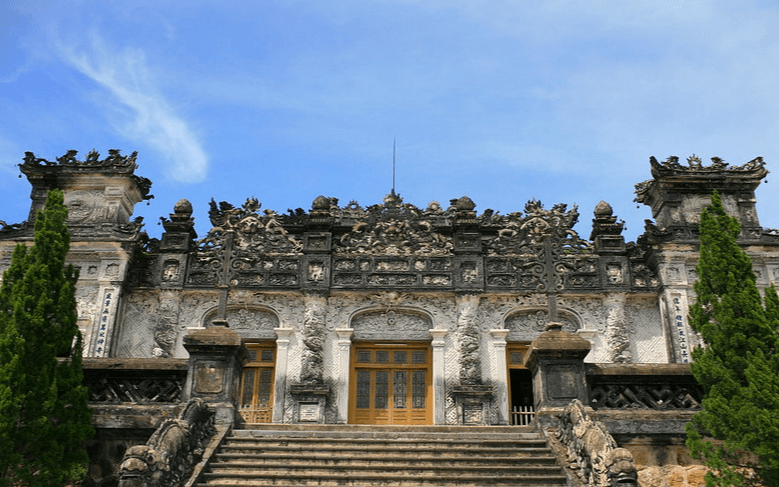
2.2.1 The masterpiece "Cửu Long Ẩn Vân" – The painting on the ceiling of Khải Định Mausoleum was painted with the feet.
According to the book "Nine Lords, Thirteen Kings of the Nguyen Dynasty," to create the masterpiece "Nine Dragons Hidden CloudsArtisan Phan Van Thanh worked in a very unique position: lying flat on his back, his hands and feet holding four brushes, with his mouth holding another brush to paint. Once, King Khai Dinh himself came and saw him using his feet to control the brush to complete the painting right in his tomb.
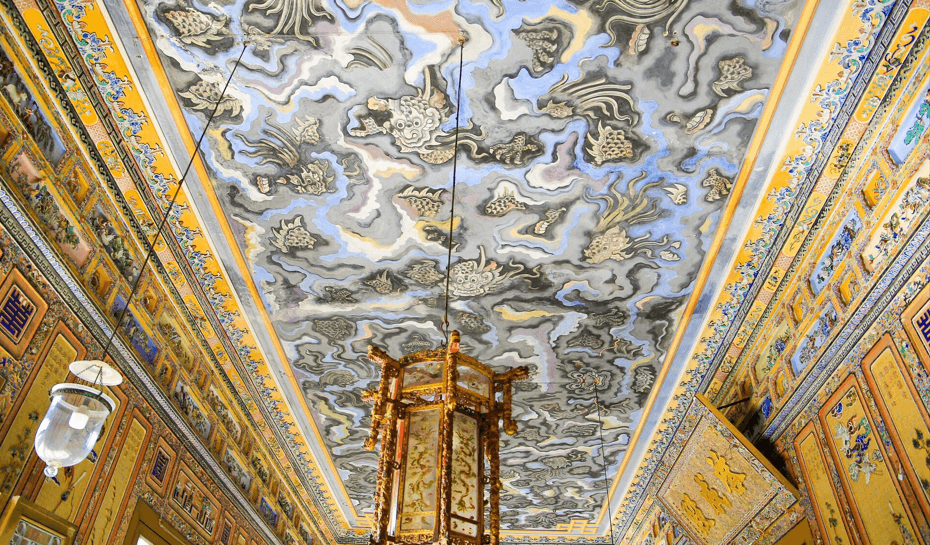
Step into Thien Dinh Palace, Visitors will encounter a solemn space with a dragon throne, memorial tablets, and a solid bronze statue of King Khai Dinh, gilded with shimmering gold. Surrounding it are walls, ceilings, and columns covered with tens of thousands of pieces of colored porcelain and glass, assembled into vibrant images of dragons, phoenixes, and flowers. Light filters through the windows, reflecting off each mosaic tile, making the entire space glow like a living painting.
When gazing upon "Nine Dragons Hidden in Clouds," it feels as if time slows down. Nine dragons twist and turn among the five-colored clouds, each with its own shape and spirit, symbolizing the supreme authority of the emperor. Light streaming through the windows reflects off the brilliant glaze, making the painting even more magical, as if the dragons are moving across the sky. That moment made me realize that Khai Dinh Mausoleum is not just a historical relic, but also a place that preserves the soul of a golden age, blending power, aesthetics, and the cultural essence of East and West.
2.2.2 The art of high-end ceramic inlay and two bronze statues of King Khai Dinh
In addition to "Cửu Long Ẩn Vân," another highlight that cannot be overlooked inside the Khải Định Mausoleum is the exquisite art of ceramic mosaic. Tens of thousands of pieces of porcelain, ceramic, and colored glass were carefully selected by artisans, polished smooth, and meticulously assembled into vivid decorative panels: dragons and phoenixes, flowers and leaves, Eastern motifs intertwined with Western styles. This technique not only required master craftsmanship but also demonstrated the creativity and refined aesthetic taste of the ancients.
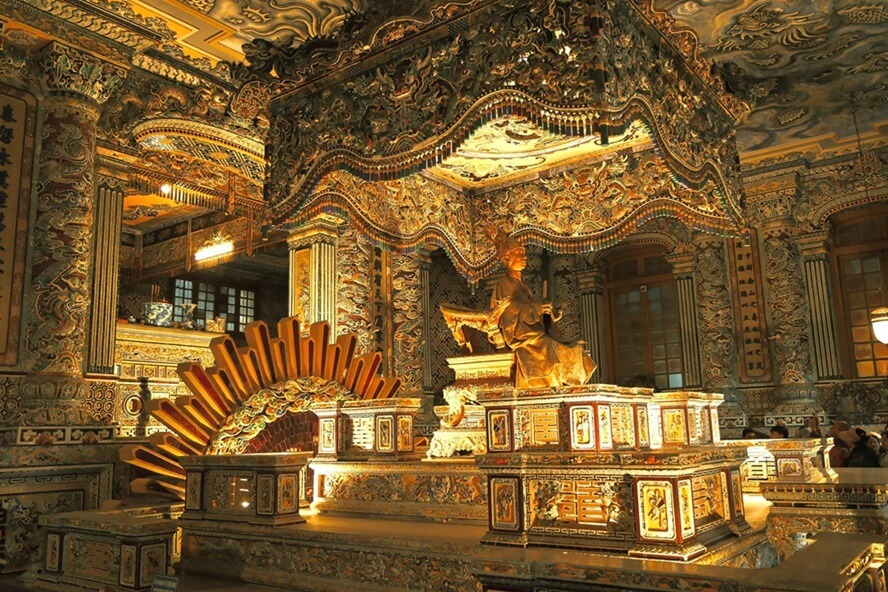
At the main hall of the Thiên Định Palace, two bronze statues of King Khải Định stand out—one seated on a gold-plated throne, placed directly in front of the altar, and one seated in a dragon robe, located in the Hue Museum (display replica). Both statues are cast from solid bronze, weighing hundreds of kilograms, and depict the king's portrait with every detail of his facial features, sitting posture, and dignified demeanor.
The combination of the statue's dazzling golden hue, the vibrant porcelain mosaic background, and the natural light streaming through the window creates a scene that is both powerful and magnificent, captivating visitors.
3. Decoding "the most": Why is the architecture of Khai Dinh Mausoleum completely different?
Within the complex Nguyen Dynasty tombsThe Khai Dinh Mausoleum in Hue stands out as a unique landmark with a series of rare "firsts": it is the smallest but took the longest to build, was the most expensive, and was most influenced by Western architecture.
From the 127 steps leading up to the Thien Dinh Palace to the exquisite ceramic mosaic art, every detail reflects the meticulousness, precision, and bold aesthetic vision of King Khai Dinh. It is this fusion of Eastern and Western elements that has transformed the mausoleum into a unique masterpiece in the history of Vietnamese architecture.
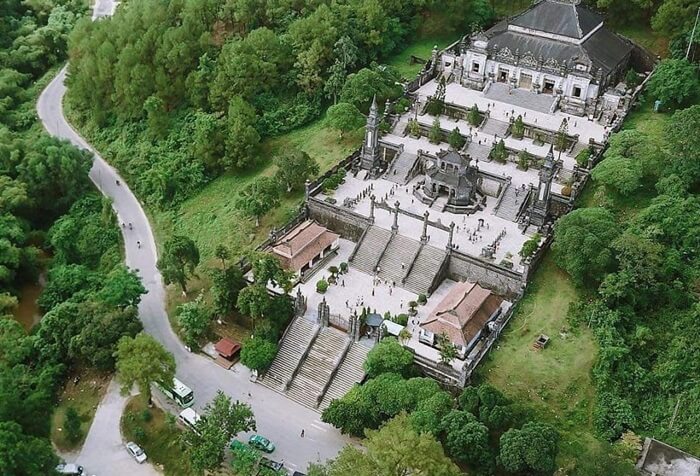
3.1 The "most expensive" mausoleum & the story of its controversial 11-year construction
Built over 11 years (1920–1931), Khai Dinh Mausoleum, Hue It consumed a huge amount of funds for both materials and labor, far exceeding any other tomb project of the Nguyen dynasty. To understand why the Khai Dinh Tomb in Hue is considered the "most expensive" project of the Nguyen dynasty, we need to look at each item that was meticulously and lavishly invested in:
- 127 stone steps The path leading from the Tam Quan Gate to the Thien Dinh Palace was crafted from high-quality solid blue stone, quarried by hand and transported dozens of kilometers from remote mountainous regions, incurring significant costs for both the stone itself and its transportation.
- The Three-Gate Pavilion and the Audience Hall Solid natural stone slabs, combined with exquisite handmade ceramic inlays. The statues of soldiers, elephants, and horses are all carved from high-quality solid stone, taking thousands of hours to complete.
- Interior walls, columns, and ceilings made from tens of thousands of pieces of porcelain and colored glass imported directly from China and Japan – luxury materials at the beginning of the 20th century, costing many times more than domestic materials.
- The "Nine Dragons Hiding in the Clouds" Painting On the ceiling of the Thien Dinh Palace is a rare masterpiece of lacquerware, requiring meticulous painting, firing, and gilding. Its value lies in the nearly lost craftsmanship and masterful skill of artisan Phan Van Thanh.
- Two bronze statues of King Khai Dinh Cast from high-quality solid bronze, it was gilded with pure gold – both the metal and casting techniques were extremely expensive at the time.
- Imported construction materialsPortland cement and steel from France (newly imported into Vietnam), glazed tiles from Japan, marble from Italy – all must be transported by sea, which is time-consuming and costly.
It is the combination of rare materials, masterful craftsmanship, and elaborate design that has made the Khai Dinh Mausoleum the most extravagant, labor-intensive, and costly structure in the history of Nguyen dynasty tombs.
3.2 The most "Westernized" mausoleum: The fusion of 5+ architectural styles
In the Nguyen dynasty's mausoleum system, Khai Dinh Mausoleum, Hue It is the most distinctively "Westernized" structure, reflecting the unique aesthetic taste and personality of King Khải Định. The architecture here is a rare blend of various Western styles and traditional Vietnamese art, creating a whole that is both unfamiliar and familiar.
- Roman style: Clearly demonstrated in the door arch semi-circular shape, thick and sturdy, creating a sense of grandeur and permanence.
- Gothic: Appearing in those spire and soaring roof, lending an air of dignity, directing the gaze upward toward the sky.
- HinduismThe mark is evident at the Tam Quan gate, with its structure and patterns reminiscent of a temple tower, creating a sense of sacredness right from the entrance.
- BaroqueReflected in the intricate, symmetrical decorative details and the harmonious arrangement of massive architectural elements.
- Art NouveauGently weaving through the winding patterns, stylized motifs, especially the reliefs and ceramic inlays.
All these elements are skillfully woven together with dragon, phoenix, lotus flower – a symbol of authority and nobility in Vietnamese court art. This East-West fusion not only makes Khai Dinh Mausoleum completely different from other tombs, but also turns it into a vivid testament to a special period of cultural exchange in history.
3.3 The "most unique" tomb: Modern construction materials and ceramic mosaic art
One of the factors that makes the Khai Dinh Mausoleum in Hue the "most unique" structure in the Nguyen dynasty's mausoleum system is the use of modern building materials—something unprecedented in Vietnamese imperial architecture. Instead of traditional wood, fired bricks, and tiles, the mausoleum was primarily constructed using reinforced concrete and steel imported from France, ensuring exceptional durability. The roof is covered with tiles. Slate (slate) imported from France, both elegant and resistant to harsh weather conditions.
This innovative approach not only reflects King Khải Định's "modernization" mindset but also ensures the structure's longevity over time. Combined with a solid architectural foundation, the ceramic mosaic art at the mausoleum has reached a masterful level of sophistication. Tens of thousands of pieces of porcelain, colored glass, and pottery were meticulously cut and assembled into vivid dragons, phoenixes, and flowers, covering the walls, columns, arches, and ceilings. Each mosaic not only has decorative value but also symbolizes the power and nobility of the royal family.
4. A-Z Travel Experience at King Khai Dinh's Mausoleum
Nestled on the slopes of Chau Chu Mountain, the Khai Dinh Mausoleum is one of the tourist destination Hue Not to be missed, it is not only the resting place of the 12th king of the Nguyen dynasty, but also a rare masterpiece of East-West architectural fusion.
As you step onto each stone stair, you will feel as if you have entered a living art museum, where the painting on the ceiling, "Cửu Long Ẩn Vân" (Nine Dragons Hiding in the Clouds), and the exquisite ceramic mosaic art tell a story of power and aesthetics. Discover the complete experience that will help you explore the tomb in a comprehensive and inspiring way.

4.1 Getting to Hue and traveling to Khai Dinh Tomb: What is the most convenient way?
Enjoy a comfortable and convenient journey to Hue with Queen Cafe Bus
Departing from Hanoi, Da Nang, or Hoi An, Queen Cafe Bus is a convenient option worth considering to reach Hue with modern limousines and comfortable private cabins. The bus stops at 7 Doi Cung – the city center, near Trang Tien Bridge, helping you easily reach your hotel and start exploring. Below is a price list for some major routes for your reference:
| BUS ROUTE TO HUẾ | PRICE | BOOK TICKETS |
| Hanoi ⇔ Hue | $15.00 – $22.50 | Place it here |
| Da Nang ⇔ Hue | $150 | Place it here |
| Hoi An ⇔ Hue | $150 | Place it here |
| Ninh Binh ⇔ Hue | $150 - $200 | Place it here |
| Quang Binh ⇔ Hue | $180 | Place it here |
📞 For attentive consultation and the fastest ticket booking, you can contact:
- Hotline: 0906.413.468 – 0914.215.809
- Zalo: 0905.746.884 – 0914.215.809
- Website: https://queenbus.com.vn/
- Fanpage: Queen Cafe Open Bus
4.2 What to wear when visiting Khai Dinh Tomb to take the best photos?
To take impressive photos at Khai Dinh Mausoleum, you should choose outfits that flatter your figure and harmonize with the ancient and majestic space of the building. Some suggestions:
- Ao dai attireTraditional or modernized ao dai are a "safe" choice but always beautiful, especially when photographed in the courtyard or on stone steps.
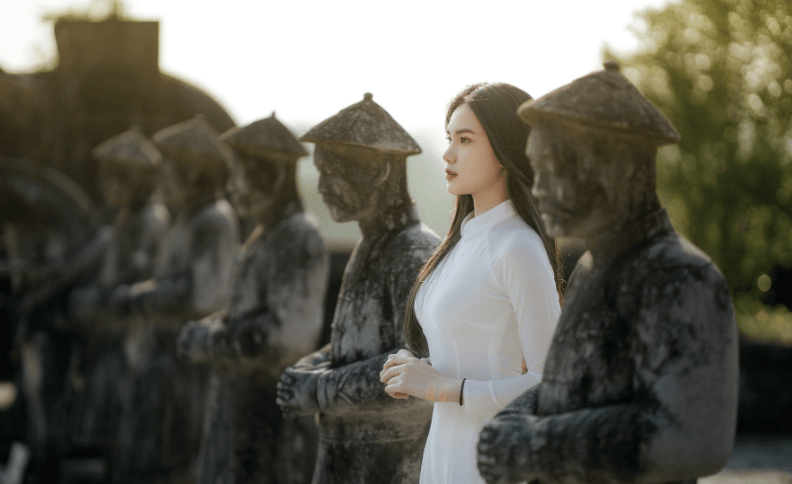
- Long dress/maxi dressWhite, beige, pale yellow, or pastel blue will stand out against the backdrop of mossy gray architecture and vibrant ceramic mosaics.

- Dark-toned clothingBlack, navy blue, or brown evoke an air of sophistication, suitable for a solemn atmosphere. inside the Khai Dinh Mausoleum.
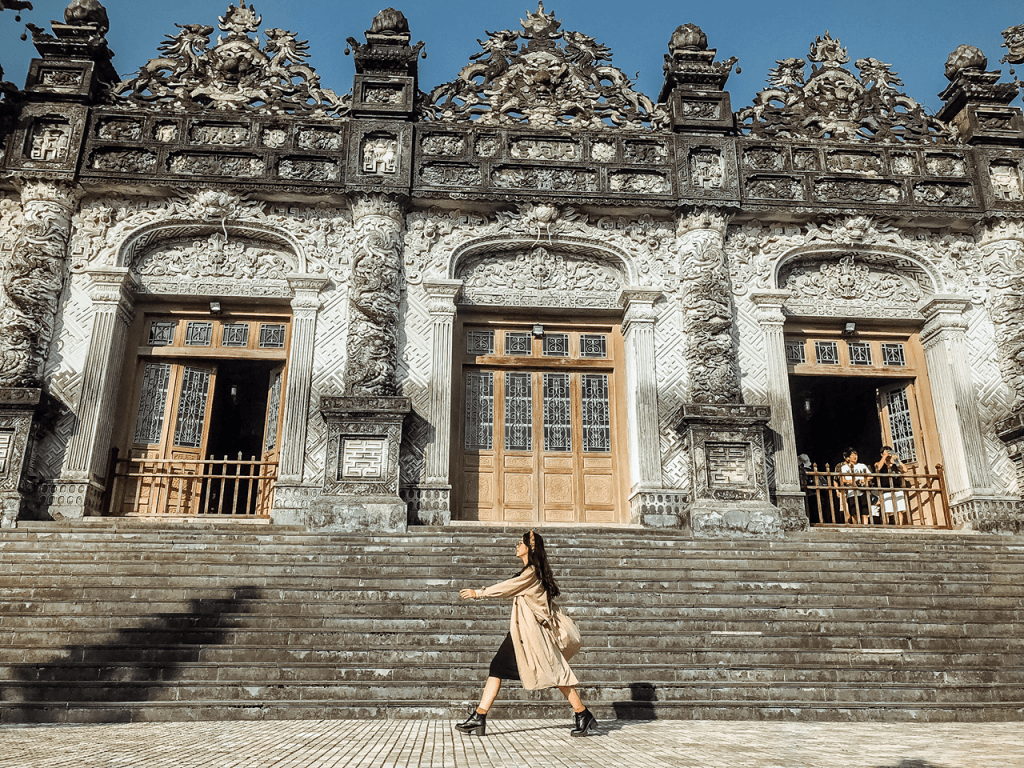
- AccessoriesA conical hat, a transparent umbrella, or a light scarf will add charm to the photo.

- ShoesChoose flat shoes or sandals for easy movement up 127 steps and across the brick courtyard.
Tip: Avoid overly bright colors or busy patterns, as they may distract from the intricate architecture of King Khai Dinh's Mausoleum.
4.3 Suggested itinerary for visiting Khai Dinh Tomb combined with nearby attractions
In just half a day, you can gather experiences that embody the spirit of the ancient capital. Khải Định Mausoleum, the poetic charm of Tu Duc Mausoleum and vibrant colors at Thuy Xuan incense village – three notable destinations in Hue.
- 8:00 AM – 9:30 AM | Khai Dinh Mausoleum
Start your journey at the tomb of King Khai Dinh in Hue, conquer 127 steps, and admire the Thien Dinh Palace with its exquisite ceramic mosaic art, the mystical "Nine Dragons Hiding in the Clouds" painting on the ceiling, and two bronze statues of King Khai Dinh. Don't forget to take time to take pictures. Photo of Khai Dinh Mausoleum from many beautiful angles.

- 9:45 AM – 10:45 AM | Tu Duc Mausoleum (about 6 km from Khai Dinh Tomb, ticket price 150,000 VND)
Continue to the tomb of King Tu Duc – one of the most poetically designed tombs of the Nguyen dynasty. The peaceful space with a lake, pine forest, and ancient pavilion will give you a feeling of tranquility that is quite different from the majesty of Tu Duc's tomb.

- 11:00 AM – 11:30 AM | Huong Thuy Xuan Village
End of the morning at Thuy Xuan incense village – A vibrant traditional craft village. Here, you can try your hand at making incense, learn about the production process, and take picturesque photos among hundreds of incense sticks arranged in the shape of flowers.
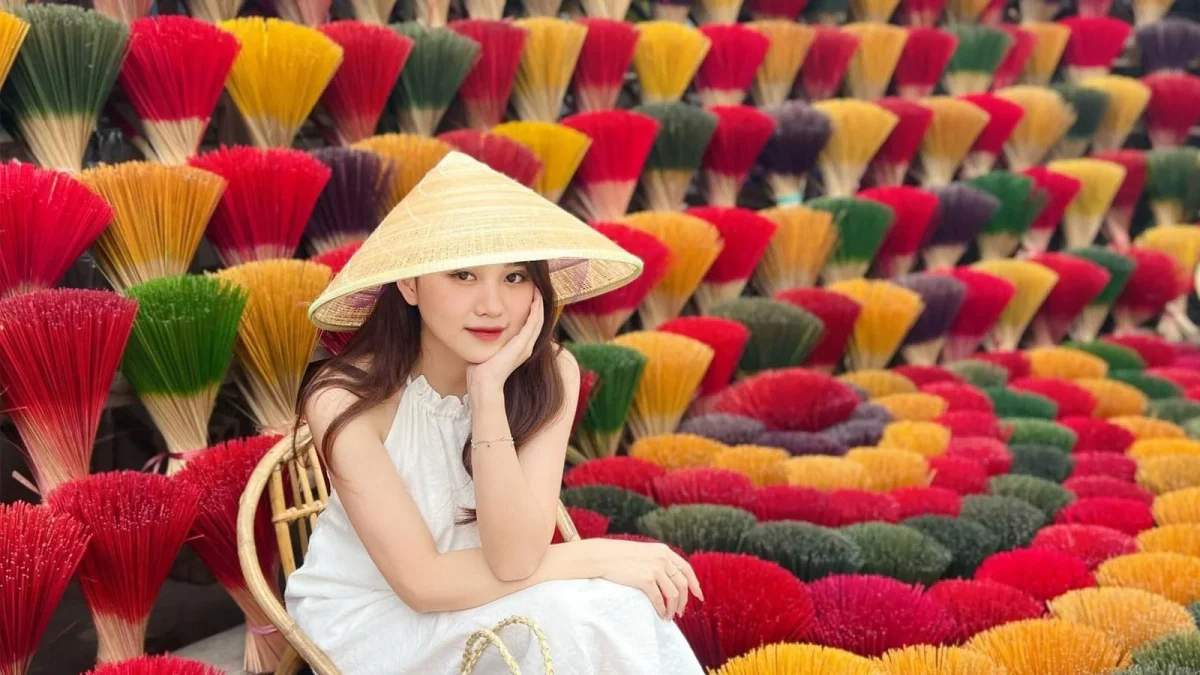
5. Answers to frequently asked questions about Khai Dinh Mausoleum
- Is Khai Dinh Mausoleum a UNESCO World Heritage Site?
Yes. Khai Dinh Mausoleum is located in Heritage Complex of the Imperial City of Hue – Recognized as a World Cultural Heritage Site by UNESCO in 1993.
- Where is the body of King Khải Định?
The remains of King Khải Định were buried in a tomb beneath the pedestal of the king's statue in Thiên Định Palace.
- What illness did King Khải Định die from?
King Khải Định died in 1925, reportedly due to tuberculosis.
- How many wives did King Khải Định have?
King Khải Định had only one official queen, Hoàng Thị Cúc, the mother of King Bảo Đại.
6. Final words
Not only is it the resting place of the 12th king of the Nguyen dynasty, Khải Định Mausoleum It is also a masterpiece that harmoniously blends the essence of Asian and European architecture. From 127 steps to the art of ceramic mosaics, The painting "Nine Dragons Hiding in the Clouds" Inside, every detail is captivating. Come along with us. Queen Cafe Bus to have a smooth, convenient journey and begin exploring this heritage to the fullest.

